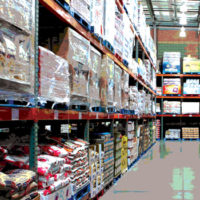Prior to the outbreak of coronavirus disease (COVID-19) and its ensuing supply chain challenges, 2020 was shaping up to be arguably the most future-focused year in food safety. Given promising developments in emerging technology and the forthcoming “New Era of Smarter Food Safety” blueprint from the U.S. Food and Drug Administration (FDA), the industry still stands ready to take action to drive out wasteful practices that have plagued the food supply chain for years and take action to achieve supply chain visibility.
Alongside these developments, the consumer is continuing to exert more influence on supply chain practices, demanding not just safer food but data as proof to support marketing claims like organic, clean, or locally sourced. This is expected to increase in importance as consumers, weary from the COVID-19 crisis, may become even more interested in transparency and building trust with the brands that they relied on to get them through challenging times. The very idea that brands and retailers would be willing to make more information available is building trust.
The year that has ushered in a new decade, 2020, already feels like a turning point for the food supply chain. Let’s expand on these top three drivers of food traceability changes—regulatory activity, technology impact, and consumer-centricity—in the year ahead and reveal the opportunities that lie in each for food safety professionals to make an impact.
Regulatory Activity: The New Era of Smarter Food Safety and FSMA
FDA’s broad initiative called “The New Era of Smarter Food Safety” was unveiled in the spring of last year. It signifies renewed energy around food traceability and inspired a number of supportive comments from various food industry organizations before the comment period closed late last year. It outlines a modern approach, building on what was set forth in the Food Safety Modernization Act (FSMA) in 2011 while also recognizing how the supply chain has changed since then.
The plan calls for collaboration and focus in four areas: tech-enabled traceability and foodborne outbreak response: smarter tools and approaches for prevention; new business models and retail modernization; and food safety culture. With obvious similarities in each of the project’s quadrants, simply put, the plan is to leverage what already works to trace food, weed out the outdated paper-based processes that hinder traceability and peer around the corner to explore what can enhance foundational traceability processes.
GS1 Standards are already playing a major role in facilitating end-to-end traceability, as they enable supply chain visibility. Data that is structured, collected and shared in a consistent manner is more likely to be effective to solve traceability challenges, and is essential to helping all supply chain partners see where product has gone, and continuously communicate key data used in a recall or withdrawal.
The food industry stakeholders that already run systems based on GS1 Standards are likely to be the ones best prepared for future traceability requirements. Food safety professionals should be aware of a broader push for education about traceability at the farm level this year, as well as a call for digital record keeping--an anticipated requirement of future FSMA rules. “One up, one back” traceability is no longer good enough. It’s time to implement more automation for greater efficiency and consumer protection.
Technology Impact: An Enhanced Understanding of Blockchain
Blockchain supports food safety initiatives and can play a critical role in creating more transparency in the supply chain to build consumer trust. The use of blockchain can lead to more accountability in the supply chain by creating an immutable ledger or audit trail of product events and transactions.
Many industry leaders are more strategically planning to use blockchain this year after learning from pilot programs over the past two years. Supply chain use cases are being evaluated for the criticality of the role blockchain played to solve a particular challenge. Many are asking “Did blockchain give us something better than what we’re using today?” In some cases, the answer is yes and in some, the answer is no.
Either way, the companies that pilot blockchain usually end up learning more about their systems’ ability to share data externally, as well as their trading partners’ data sharing capabilities. Blockchain programs have surfaced data quality issues and inconsistencies that need to be addressed. In fact, a recent Gartner study concluded that from 2020 through 2022, 80 percent of supply chain blockchain initiatives will remain at a pilot stage instead of emerging into broad-based applications. The researchers point to the fact that many supply chain use cases still rely on events that are stuck in the “analog world,” such as events and data occurring across physical products, packaging layers, and transportation assets.
Blockchain can do a lot of things but it can’t magically make your data ready for the permanence of an immutable ledger or give you instant supply chain visibility. This year, look for a more thoughtful approach to blockchain adoption that incorporates global data standards and more stringent data governance to ensure wise investments are made.
Consumer-Centricity: Closing the Gap
A recent study by Deloitte found that over the last two years, more than 60 percent of consumers increased spending on the fresh food category. Other research from the Center for Food Integrity found that 65 percent of consumers want to know more about where their food comes from.
As consumers continue to diversify their diets, it will be increasingly important for food brands and retailers to provide trustworthy information, which leads to peace of mind. By prioritizing food traceability, the industry can work together to close the gap between consumer demand for fresh, healthy food and the industry’s ability to meet that demand with assurance of safety.
In the year ahead, look for increased collaboration between trading partners to more easily identify the location where a product was harvested and produced. This will help them complete the full picture of traceability for consumers. A key data standard that can help create efficiencies here is the Global Location Number, which uniquely identifies a company’s physical locations such as a store or a warehouse. This number can be universally accepted in trading partner systems and is a key part of traceability programs because they allow for more precise recording and sharing of supply chain events.
By keeping an eye on these key drivers of change, the food industry can be well-prepared to navigate through an increasingly disruptive year. Now more than ever, continued collaboration between supply chain partners is critical to fuel the journey.
Angela Fernandez is the vice president of community engagement at GS1 US and leads community initiatives—including the Foodservice GS1 US Standards Initiative and the GS1 US National Data Quality Program—which seek to solve supply chain challenges through the implementation of GS1 Standards.
The Three Drivers of Food Traceability Changes

Looking for a reprint of this article?
From high-res PDFs to custom plaques, order your copy today!








